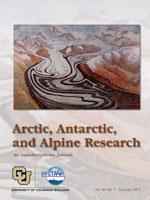Local mountain meteorology of the landscape around Longyearbyen in central Svalbard is analyzed through the decade from 2000 to 2011. Standard meteorological stations from close to sea level and up to 464 m a.s.l. located on different periglacial landforms, have been used. During winters with little sea ice, strong temperature inversions do not develop, and then there is a distinct cooling with height, as opposed to when sea ice is present. Airflow is accelerated due to topography and direction deflected in the confined valleys, whereas open plateaus have on average 1 m/s lower wind speeds with a regional SE direction. The permafrost thermal state is largely controlled by meteorology, with permafrost in the valley bottoms as cold as on the mountain plateaus. The periglacial landform most exposed to climatic variability is ice-wedges, which seem to crack mainly during shorter cooling periods. Such activity is also linked to temperature inversions, and thus also occur mainly when sea ice is present. Solifluction is mainly controlled by the balance between summer thawing and winter freezing in combination with snow dynamics, whereas avalanches are mainly wind controlled. Avalanches and avalanche controlled landforms are least sensitive to climatic variability.
How to translate text using browser tools
1 February 2013
Central Svalbard 2000–2011 Meteorological Dynamics and Periglacial Landscape Response
Hanne H. Christiansen,
Ole Humlum†,
Markus Eckerstorfer





